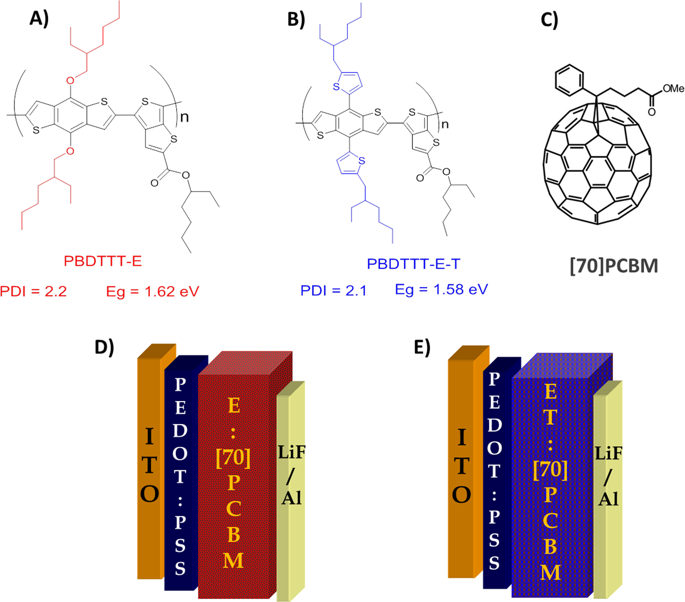Scientific Reports ( IF 3.8 ) Pub Date : 2019-03-13 , DOI: 10.1038/s41598-019-40948-1 Nutifafa Y. Doumon , Gongbao Wang , Xinkai Qiu , Adriaan J. Minnaard , Ryan C. Chiechi , L. Jan Anton Koster

|
The last decade saw myriad new donor polymers, among which benzodithiophene-co-thienothiophene polymers are attractive due to their relatively high power conversion efficiency in bulk heterojunction solar cells. We examine the effect of UV-light on the stability of these polymers. The relationship between the polymer chemical structure and the UV-stability of the cells is explored on the one hand, and on the other hand, the effect of additives on their UV-stability: 1,8-diiodooctane against 1-chloronaphthalene in the cells and 1,8-octanedithiol in solution. For example, PBDTTT-E with 18% efficiency loss is more stable than PBDTTT-ET with 36% loss throughout the exposure. While 1,8-diiodooctane acts as photo-acid and leads to accelerated degradation of the solar cells, 1-chloronaphthalene does not. Acidity is known to be detrimental to the efficiency and stability of organic solar cells. The degradation is initiated upon UV-irradiation by the cleavage of the side chains, resulting in more electron traps and by the formation of iodine, dissolved HI and carbon-centered radicals from 1,8-diiodooctane as revealed by 1H NMR spectrum. The 1,8-octanedithiol spectra do not show such species. Finally, the mechanisms behind the effect of 1,8-diiodooctane are explained, paving the way for the design of new, efficient as well as stable materials and additives.
中文翻译:

1,8-二碘辛烷在有机太阳能电池中充当光酸
在过去的十年中,出现了无数新的供体聚合物,其中苯并二噻吩-共噻吩并噻吩聚合物由于在体异质结太阳能电池中具有相对较高的功率转换效率而具有吸引力。我们研究了紫外线对这些聚合物稳定性的影响。一方面探讨了聚合物化学结构与细胞的紫外线稳定性之间的关系,另一方面,研究了添加剂对其紫外线稳定性的影响:1,8-二碘辛烷对细胞中的1-氯萘的影响和1,8-辛二硫醇溶液。例如,在整个暴露过程中,效率损失为18%的PBDTTT-E比效率损失为36%的PBDTTT-ET更稳定。1,8-二碘辛烷用作光酸并导致太阳能电池加速降解,而1-氯萘则不能。已知酸度对有机太阳能电池的效率和稳定性有害。降解是通过侧链的裂解紫外线辐射而引发的,从而导致更多的电子陷阱,以及由1,8-二碘辛烷形成的碘,溶解的HI和以碳为中心的自由基,如1 H NMR谱。1,8-辛二硫醇光谱未显示此类物质。最后,解释了1,8-二碘辛烷的作用机理,为新型,高效,稳定的材料和添加剂的设计铺平了道路。


















































 京公网安备 11010802027423号
京公网安备 11010802027423号